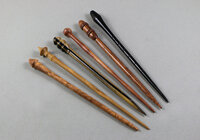This document shows the tools and methods I use to hold, shape, and successfully finish a thin spindle. I wrote this update for a recent club demo.
As spindles get long and thin, there are challenges to turn them successfully. My demos use “magic” wands to show the techniques but they apply to many types of thin spindles. I always take some long examples, a couple of tapered shafts that go from about 1/2” diameter down to 1/16” diameter in more than 24” - one I turned from a piece of shelving pine board from Home Depot.
Some things covered here are about the wood itself and how to prepare it, the tradeoffs between various methods of holding the work on the lathe, how to support the thin sections wood while turning (I don’t use a steady rest), some tools I use and why, lathe speed, and more. Some are techniques I developed as I learned. I have turned 100s of the wands over the years as well as other spindles such as conductors batons. I mostly give these (and other turnings) away but I have accidentally made a few thousand $$ without trying.
While writing this document, I followed every step to make sure I didn’t leave anything out, and made a wand from start to finish. At the recent demo I passed that wand around - I included a photo of it at the bottom of page 23.
If these techniques interest someone, enjoy!
BTW, my primary tool for thin spindles is the skew chisel and was surprised to learn how few people use the skew - some have had a bad experience and started using it only for scraping. Some were warned by “experts” to stay away from the evil skew. To combat this, I start all beginners with the skew, even if they have never seen a lathe before. So far this has always been successful with the method I developed - to date I have never had a student get a catch while learning! And I have occasionally taught remedial skew lessons to old-timers. Good clean fun!
As always, suggestions and corrections for a future update are welcome.
JKJ
As spindles get long and thin, there are challenges to turn them successfully. My demos use “magic” wands to show the techniques but they apply to many types of thin spindles. I always take some long examples, a couple of tapered shafts that go from about 1/2” diameter down to 1/16” diameter in more than 24” - one I turned from a piece of shelving pine board from Home Depot.
Some things covered here are about the wood itself and how to prepare it, the tradeoffs between various methods of holding the work on the lathe, how to support the thin sections wood while turning (I don’t use a steady rest), some tools I use and why, lathe speed, and more. Some are techniques I developed as I learned. I have turned 100s of the wands over the years as well as other spindles such as conductors batons. I mostly give these (and other turnings) away but I have accidentally made a few thousand $$ without trying.
While writing this document, I followed every step to make sure I didn’t leave anything out, and made a wand from start to finish. At the recent demo I passed that wand around - I included a photo of it at the bottom of page 23.
If these techniques interest someone, enjoy!
BTW, my primary tool for thin spindles is the skew chisel and was surprised to learn how few people use the skew - some have had a bad experience and started using it only for scraping. Some were warned by “experts” to stay away from the evil skew. To combat this, I start all beginners with the skew, even if they have never seen a lathe before. So far this has always been successful with the method I developed - to date I have never had a student get a catch while learning! And I have occasionally taught remedial skew lessons to old-timers. Good clean fun!
As always, suggestions and corrections for a future update are welcome.
JKJ
Attachments
Last edited:


